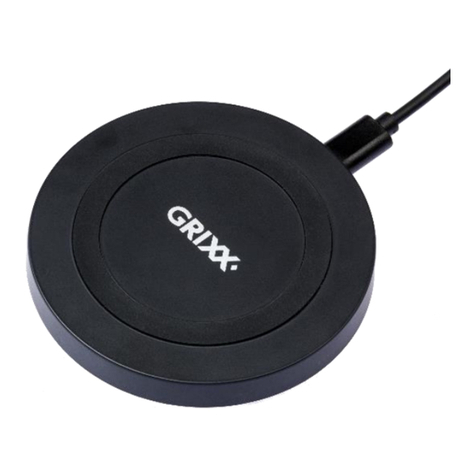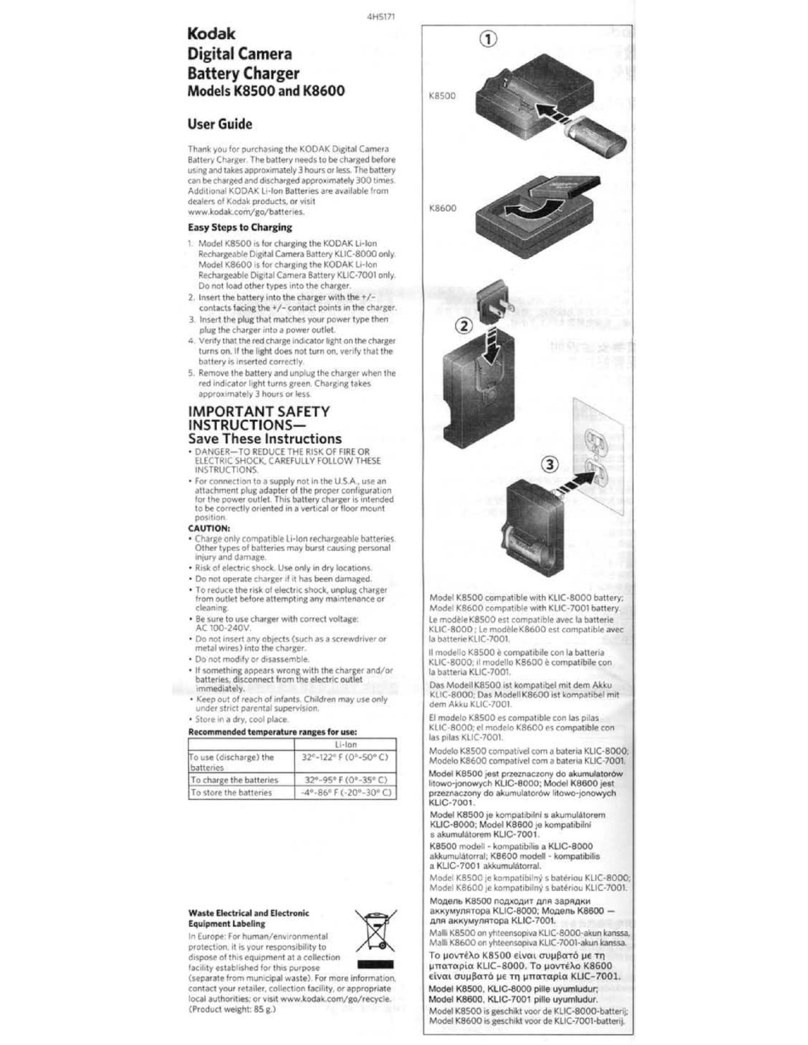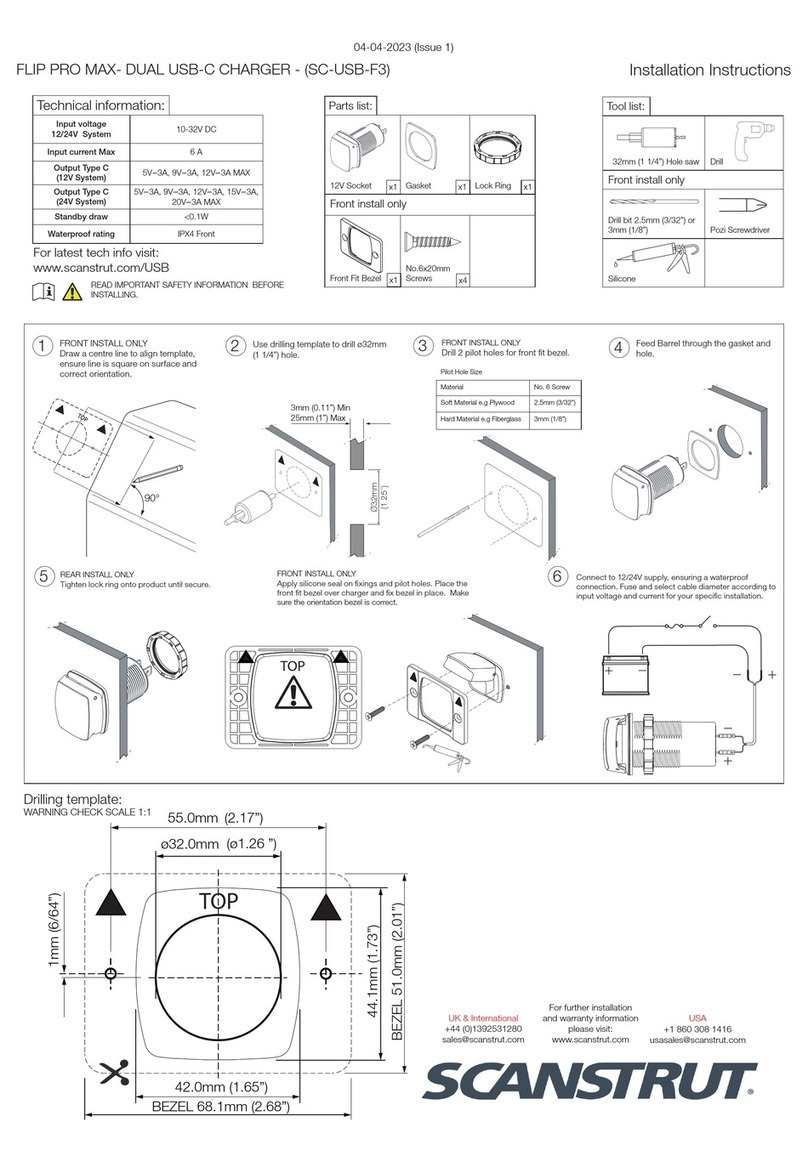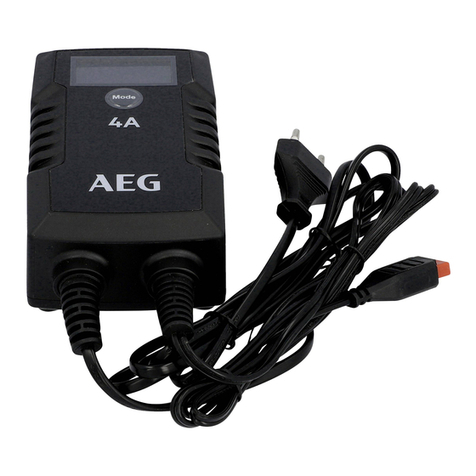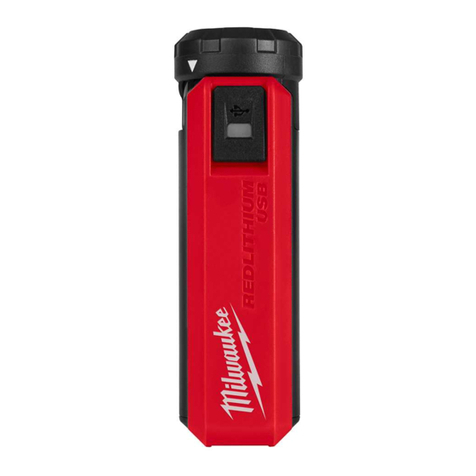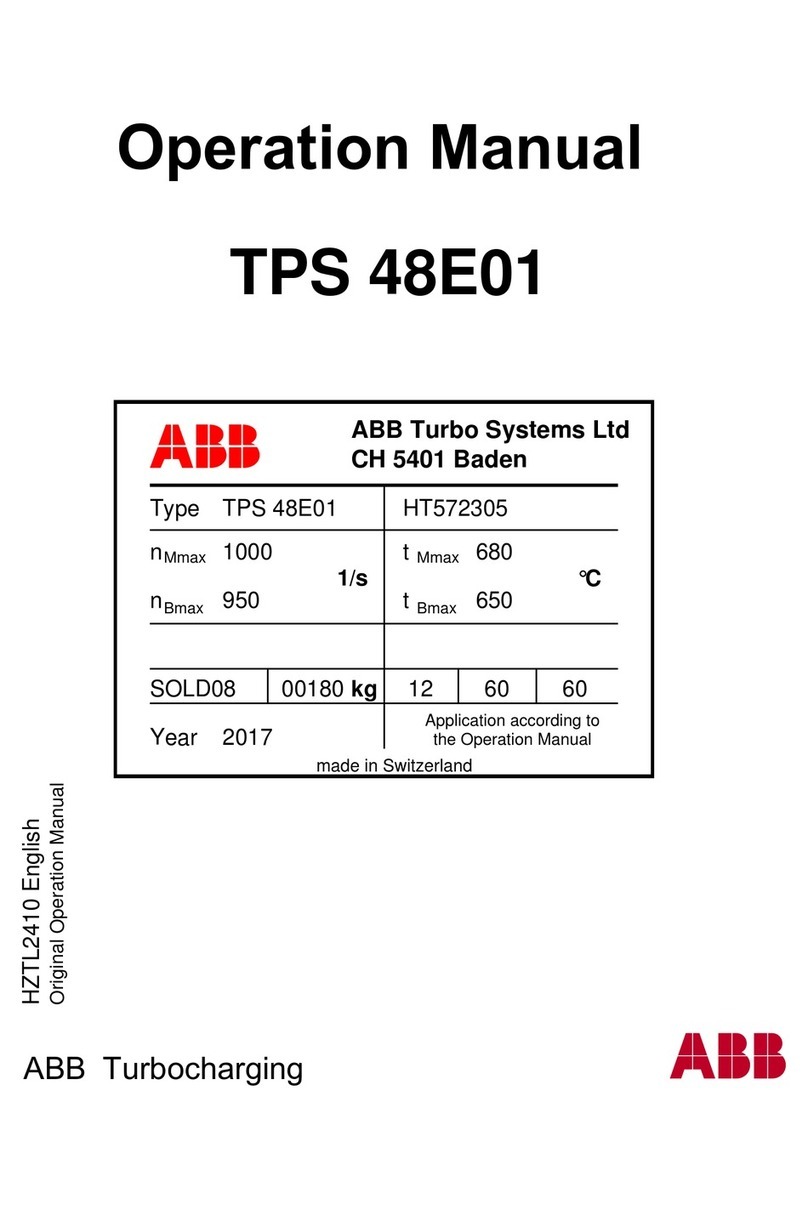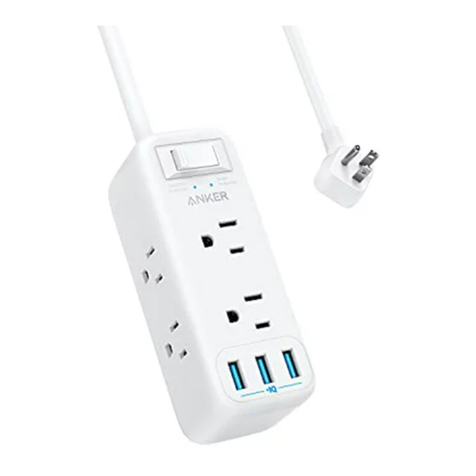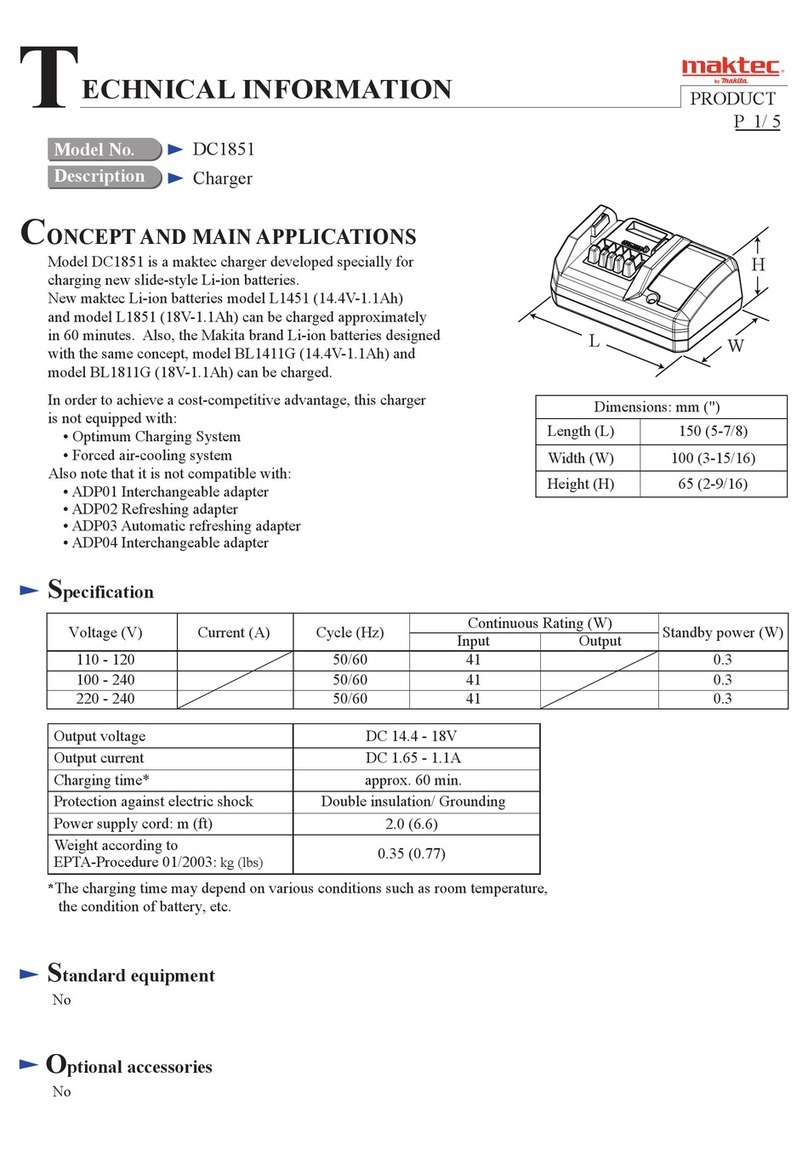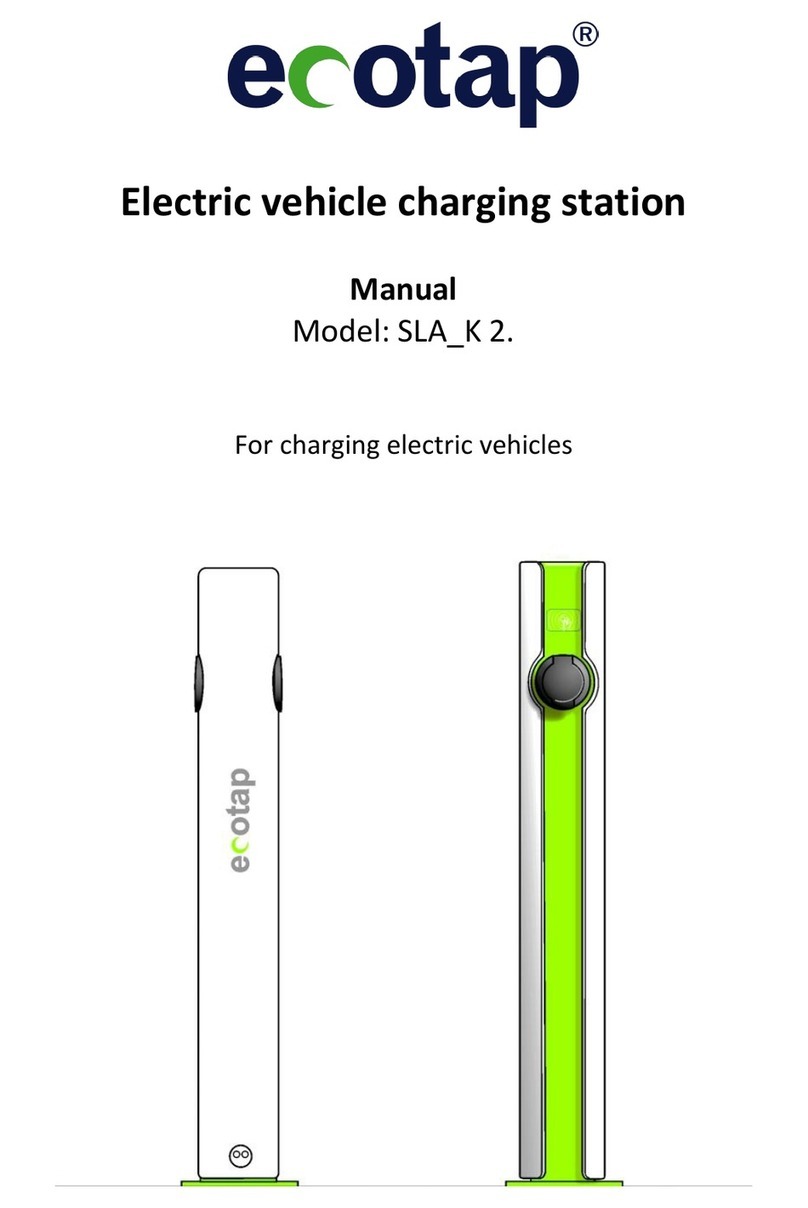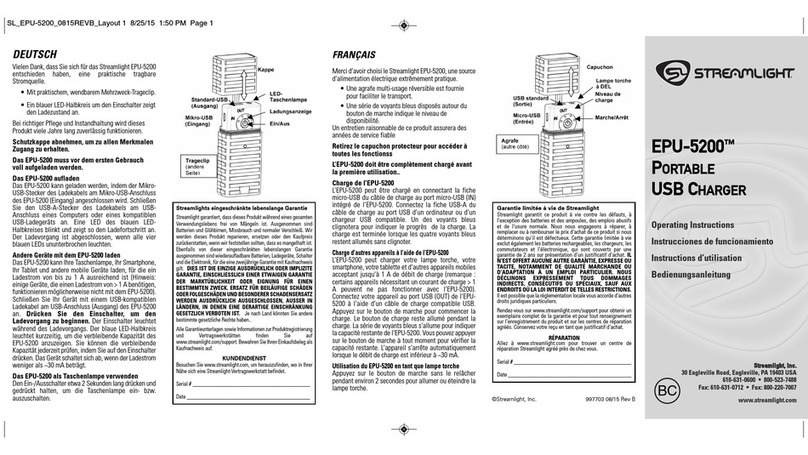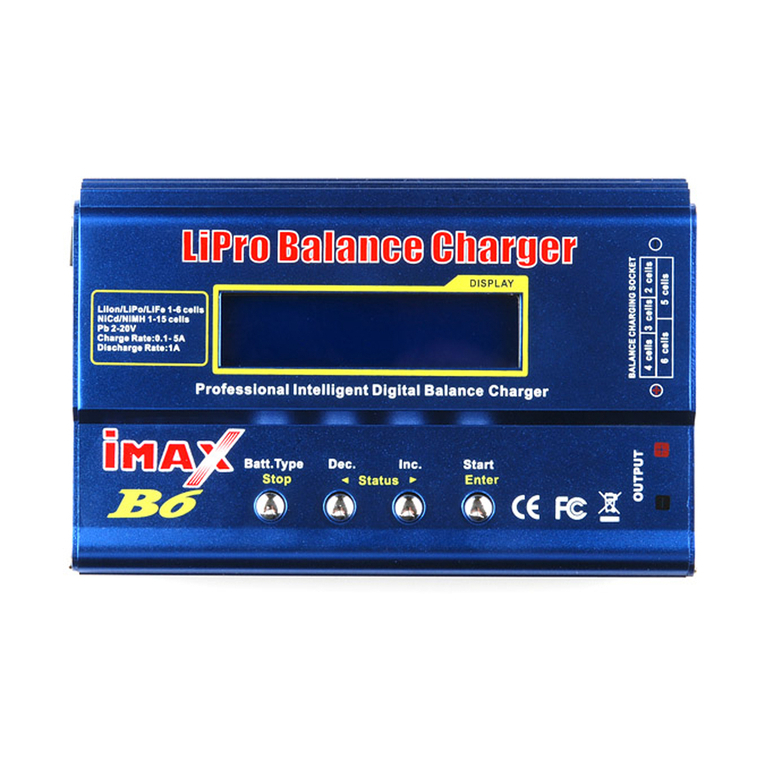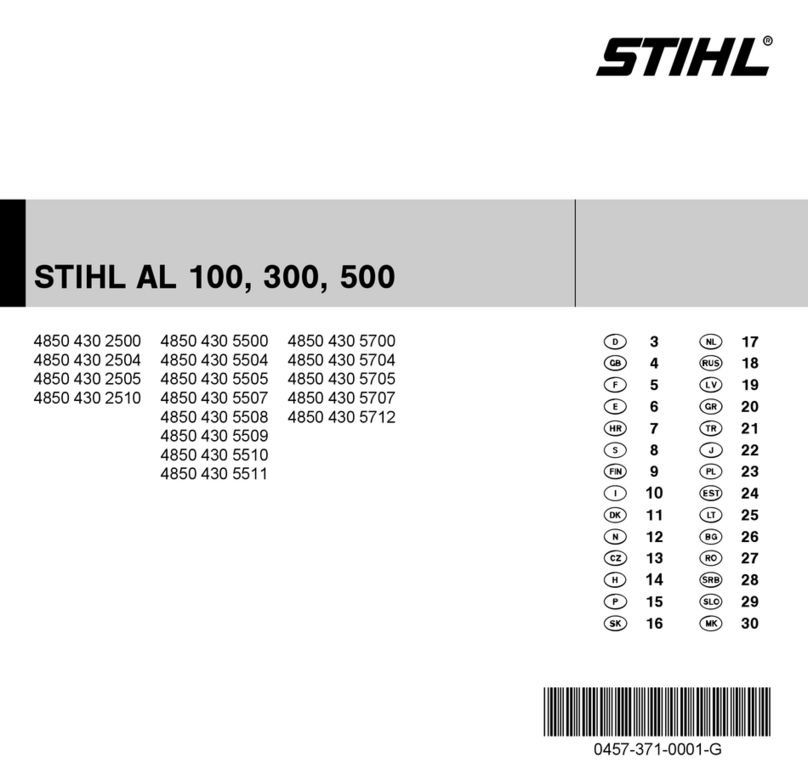Enerdrive ePOWER Charger EN31220 User manual

Owner’s Manual
EN31220 - ePOWER Charger 12V / 20Amp
EN31240 - ePOWER Charger 12V / 40Amp
EN31260 - ePOWER Charger 12V / 60Amp
EN32430 - ePOWER Charger 24V / 30Amp
Enerdrive ePOWER Battery Charger Owner’s Manual (Rev. 0 4) March 2015

Enerdrive ePOWER Battery Charger Owner’s Manual (Rev. 0 4)
Page 2
Please Keep This Manual For Future Reference
For safe and optimum performance, the Enerdrive ePOWER Battery Charger must be used
properly. Carefully read and follow all instructions and guidelines in this manual and give special
attention to the CAUTION and WARNING statements.
Disclaimer
While every precaution has been taken to ensure the accuracy of the contents of this guide,
Enerdrive assumes no responsibility for errors or omissions. Note as well that specications and
product functionality may change without notice.
Important
Please be sure to read and save the entire manual before using your Enerdrive ePOWER Battery
Charger. Misuse may result in damage to the unit and/or cause harm or serious injury. Read
manual in its entirety before using the unit and save manual for future reference.
Product Numbers - ePOWER Battery Charger Series
EN31220 ePOWER Battery Charger 12V / 20Amp
EN31240 ePOWER Battery Charger 12V / 40Amp
EN31260 ePOWER Battery Charger 12V / 60Amp
EN32430 ePOWER Battery Charger 24V / 30Amp
ePOWER Battery Charger Owners Manual Rev. 04. This Manual applicable to all units with serial
number prex EN.
Service Contact Information
ENERDRIVE PTY LTD
Unit 11, 1029 Manly Road Tingalpa, Queensland, Australia 4173
Ph: 1300 851 535 / Fax: 07 3390 6911
Email: sales@enerdrive.com.au | Web: www.enerdrive.com.au

Page 3
www.enerdrive.com.au
Notice of Copyright
Enerdrive ePOWER Battery Charger owner’s manual © 2012-2014 Enerdrive . All rights reserved.
No part of this document may be reproduced in any form or disclosed to third parties without the
express written permission of Enerdrive Pty Ltd, Unit 11, 1029 Manly RoadTingalpa, Queensland,
Australia 4173. Enerdrive reserves the right to revise this document and to periodically make
changes to the content hereof without obligation or organization of such revisions or changes,
unless required to do so by prior arrangement.
Exclusions For Documentation And Product Usage
1. Unless specically agreed to in writing, Enerdrive Pty Ltd : makes no warranty as to the
accuracy, suciency or suitability of any technical or other information provided in its
manuals or other documentation
2. Assumes no responsibility or liability for losses, damages, costs or expenses, whether
special, direct, indirect, consequential or incidental, which might arise out of the use of such
information.The use of any such information will be entirely at the user’s risk
3. Reminds you that if this manual is in any language other than English although steps have
been taken to maintain the accuracy of the translation, the accuracy cannot be guaranteed.
4. Makes no warranty, either expressed or implied, including but not limited to any implied
warranties of merchantability or tness for a particular purpose, regarding these Enerdrive
products and makes such Enerdrive products available solely on an“as is”basis.
5. Shall in no event be liable to anyone for special, collateral, incidental, or consequential
damages in connection with or arising out of purchase or use of these Enerdrive products.The
sole and exclusive liability to Enerdrive, regardless of the form of action, shall not exceed the
purchase price of the Enerdrive products described here in.

Table of Contents
1. INTRODUCTION 6
2. PRODUCT DESCRIPTION 8
3. UNDERSTANDING THE UNIT 9
Silent Mode 10
Multistage Charging Process 11
Smart Charging Feature 12
Battery Charger Voltage 14
Battery Bank Size Recommendation 14
4. INSTALLING THE CHARGER 15
Mounting The Charger 15
Chassis Grounding Connection 17
DC Output Wiring 17
Recommended Cable Length, Size And Required Fuse Size 17
Standard Temperature Sensor Connection 18
Optional Remote Display Connection 18
Running The ePOWER Battery Charger With Portable Generators 19
Battery Wiring: Connecting The Batteries The Right Way 20
5. UNIT OPERATION 21
Understanding The Charging Mechanism 21
For Charging GEL, AGM And Flooded Batteries 21
For Charging Lithium Batteries 22
Enerdrive ePOWER Battery Charger Owner’s Manual (Rev. 0 4)
Page 4

For Using Charger As Power Supply (Program Setting) 22
Understanding The Display And Function Keys During Normal Operation 22
Understanding The Function Key‘MENU’,‘SET’And‘SEL’During Charger Setting 23
Understanding The Three-Stage (Mode 3) Charging 23
Understanding The Two-Stage (Mode 2) Charging 23
Understanding The Battery Temperature Functions 24
ProcedureTo Set Or View Charger Setting 25
GEL, AGM Or Flooded Battery Type: 25
Lithium Battery Type 26
Program (Power Supply) Type 27
ProcedureTo Equalize Flooded Battery 27
Understanding The Silent Mode Function 29
Understanding The Protection Features 30
Charging A Dead Battery 30
Understanding The Error Codes 31
6. SPECIFICATIONS 32
7. WARRANTY 34
Two Year Limited Warranty 34
Return and/or Repair Policy 35
Limitations 35
8. Appendix 1 36
9. Appendix 2 38
Page 5
www.enerdrive.com.au

1. INTRODUCTION
Thank you for purchasing the Enerdrive ePOWER Battery Charger. With
our state of the art, easy to use design, this product will oer you reliable
service for providing a multistage, multi-bank battery charger to charge
the dierent types of batteries you have installed in either your home,
boat, caravan, 4WD or commercial vehicle. This manual will explain
how to use this unit safely and eectively. Please read and follow these
instructions and precautions carefully.
IMPORTANT SAFETY INFORMATION
This section contains important safety information for the Enerdrive ePOWER
Battery Charger. Each time, before using the Enerdrive ePOWER Battery
Charger, READ ALL instructions and cautionary markings on or provided with
the battery charger, and all appropriate sections of this guide. The Enerdrive
ePOWER Battery Charger contains no user serviceable parts. Opening up the
charger will void product warranty. See Warranty section for how to handle
product issues.
WARNING
FIRE AND/OR CHEMICAL BURN HAZARD
Do not cover or obstruct any air vent openings and/or install in a zero-
clearance compartment.
WARNING
SHOCK HAZARD. KEEP AWAY FROM CHILDREN!
Avoid moisture ingress. Never expose the unit to snow, water, etc.
Enerdrive ePOWER Battery Charger Owner’s Manual (Rev. 0 4)
Page 6

WARNING
FAILURE TO FOLLOW THESE INSTRUCTIONS CAN
RESULT IN DEATH OR SERIOUS INJURY
When working with electrical equipment or lead acid batteries, have
someone nearby in case of an emergency.
Study and follow all the battery manufacturer’s specic precautions when
installing, using and servicing the battery connected to the charger.
Wear eye protection and gloves.
Avoid touching your eyes while using this unit.
Keep fresh water and soap on hand in the event battery acid comes in
contact with eyes. If this occurs, cleanse right away with soap and water for
a minimum of 15 minutes and seek medical attention.
Batteries produce explosive gases. DO NOT smoke or have an open spark or
re near the system.
Never attempt to re-charge a damaged, frozen or non-rechargeable battery.
Keep unit away from moist or damp areas.
Avoid dropping any metal tool or object on the battery. Doing so could
create a spark or short circuit which goes through the battery or another
electrical tool that may create an explosion.
Battery charger must be plugged in to an earthed and Australian Standards
compliant mains supply. If the units power cable is damaged, replace the
cable immediately.
Page 7
www.enerdrive.com.au

WARNING: EXPLOSION HAZARD!
DO NOT use the Enerdrive ePOWER Battery Charger in the vicinity of
ammable fumes or gases (such as gas bottles or large engines).
AVOID covering the ventilation openings. Always operate unit in an open
and well ventilated area.
Prolonged contact to high heat or freezing temperatures will decrease the
working life of the unit.
LIMITATIONS OF USE
Do not use in connection with life support systems or other medical
equipment or devices.
Charger is not to be used by persons with reduced physical or mental
capabilities or lack of knowledge and experience. Not to be operated or
used by children.
2. PRODUCT DESCRIPTION
The Enerdrive ePOWER Battery Charger package includes the items
listed below.
• ePOWER Battery Charger
• Battery Temperature Sensor (7.5 Meter Cable)
• IEC 240Vac Power Lead
• Owner’s manual rev 2
• Appendix A1 rev 3 (see page 36 & 37 of this manual)
• Appendix A2 rev 3 (see page 39 & 39 of this manual)
Enerdrive ePOWER Battery Charger Owner’s Manual (Rev. 0 4)
Page 8

3. UNDERSTANDING THE UNIT
The Enerdrive ePOWER Battery Charger is a fully automatic multistage
battery charger with the ability to charge 3 separate battery banks.
When rst connected to an AC power source, the charger will check all
three battery banks before charging commences. The ePOWER Battery
Charger operates on an isolated charging design where battery bank
one is separate from battery bank two and three. Battery bank one is the
priority battery bank in the charging sequence and must be connected
to the primary house (or main) battery bank. Battery bank one can be
programmed with a dierent charge algorithm over banks two and
three.
Battery bank two and three are connected in parallel internally (with a
separation diode) and share a common charge algorithm.
During normal operation the ePOWER Battery Charger will do a full
charge cycle to oat stage on battery bank one with battery types
set to either GEL, AGM, FLOODED or LITHIUM (see Lithium section for
limitations of use). Once oat stage is reached the charger transitions
to charge banks two and three together with a bulk / absorption mode
(battery banks two and three can be set to either GEL, AGM or FLOODED).
On completion all three battery banks move to oat stage with a shared
battery voltage determined by bank one settings. This setting allows
the charger to remain permanently connected to mains if required.
CAUTION
Battery bank one should ONLY be connected to the main battery bank that
requires charge priority.
On single battery bank installations DO NOT use bank two and three charger
outlets.
Page 9
www.enerdrive.com.au

AC Output Wiring Compartment
AC Power Cable
Battery Temperature Sensor Port
Digital Display Port
Battery Positive Bank 3
Battery Positive Bank 2
Battery Positive Bank 1
Battery Negative Common
DC Output fuses
Unit Ground
Silent Mode
A unique feature of the Enerdrive ePOWER Battery Charger is the ability
to disable the cooling fan for total silent operation at night or whenever
required. This setting is manually activated via the display and remains
active for a period of 12 hours, or until manually deactivated. Please
note that the charger output will be reduced while in silent mode,
leading to longer required recharge times.
Enerdrive ePOWER Battery Charger Owner’s Manual (Rev. 0 4)
Page 10

Multistage Charging Process
The ePOWER Battery Charger is a fully automatic, set and forget charger.
It is designed to quickly and accurately recharge your deep cycle
batteries utilising charger algorithms that help to maximise the life of
your specialised deep cycle batteries.
All ePOWER Battery Chargers feature multistage smart charging
technology that enables the charger to be connected to your battery
banks permanently.
The ePOWER Battery Charger utilise high frequency power switching
circuits to convert the normal mains 240 volts AC (via either shore or
generator power), to the required low voltage DC required to charge
the batteries.
As dictated by battery manufacturer’s recommendations, deep cycle
batteries require a multistage charge sequence for perfect, fast and
accurate charging. Enerdrive multistage smart chargers delivers four
primary charge stages.
Stage 1 – Bulk or Boost charge; The battery is charged at full rated
output current of the charger until the battery reaches its nal charging
voltage, known as its absorption voltage. In this step, around 80% of the
battery is recovered as fast as possible.
Stage 2 – Absorption Charge; With the charger voltage held steady,
the remaining 20% is replaced with the charger allowing the current to
taper o as the battery approaches its full charge.
Stage 3 – Float; Finally, in the oat stage the charger voltage is lowered
and held at a constant and safe predetermined level. This prevents
the battery from being overcharged, yet allows the charger to supply
enough current to make up for the self discharge losses of the battery,
while supporting any additional loads connected to the battery (such
as DC lighting and refrigerators). This stage allows for the charger to be
used as a DC power supply.
Page 11
www.enerdrive.com.au

Stage 4- Maintenance stage is a regular timed recharge (or return
to bulk stage). The Enerdrive ePOWER Battery Charger switches the
charger from oat to boost after 7 days of constant operation to ensure
the battery banks remain active.
Smart Charging Feature
The ePOWER Battery Charger will regulate its output based on the loads
connected to your battery banks. This function is important to maintain
the life of your battery banks as some battery chargers mistake loads for
discharge and continue to keep the batteries in the bulk or absorption
stage for extended periods of time, which will damage the battery bank.
The ePOWER Battery Charger has two methods of load based regulation
to ensure your battery charger transitions to oat when it should do so.
ePOWER charger algorithm
Note: Actual voltages dependent on chosen algorithm.
In the event o AC mains loss the charger will react according to time without mains power.
Loss of AC power for less than 4min - Charge resumes at existing stage.
Loss of AC power for more than 4min - Charge resumes at bulk stage.
See page 27 for Lithium denition.
Enerdrive ePOWER Battery Charger Owner’s Manual (Rev. 0 4)
Page 12

Page 13
www.enerdrive.com.au

Battery Charger Voltage
Battery Type Absorption Float Equalisation
GEL 14.4 V 13.7 V N.A.
AGM 14.7 V 13.6 V N.A.
Flooded 14.4 V 13.3 V 15.5 V (See Note1)
Lithium Constant 14.2 V, 14.3 V, 14.4 V (See Note2) N.A
Program (Power Supply) Constant 13.3 V, 13.5 V, 13.7 V (See Note3) N.A
* For 24V model charger multiply above voltages by 2.
** For Concorde™ branded batteries (lifeline, sun xtender) use ooded setting and consult battery
supplier for equalisation recommendations
Note 1: Equalisation setting can only be used on ooded battery type selection only. See
more details on Procedure to Equalise the Flooded Battery.
Note 2: Charger will terminate charging when charging current drop to below the set charger
termination value.
Note 3: Charger is acting as a power supply with selected constant output voltage and preset
maximum output current. With this setting, only Bank 1 can be used, Bank 2 and 3 is disabled.
Battery Bank Size Recommendation
The battery charging current rating is based on the battery size. Each
battery bank should meet the minimum Ah rating as shown. If a smaller
size battery bank is used, set the current rating to lower value to match
with the battery bank size. Normally, the minimum battery bank capacity
is based on twice the charger current rating.
EN31220 EN31240 EN31260 EN32430
Current
Setting
Battery
Capacity
Current
Setting
Battery
Capacity
Current
Setting
Battery
Capacity
Current
Setting
Battery
Capacity
5A Min 10Ah 5A Min 10Ah 5A Min 10Ah 5A Min 10Ah
10A Min 20Ah 10A Min 20Ah 20A Min 40Ah 10A Min 20Ah
15A Min 30Ah 20A Min 40Ah 40A Min 80Ah 20A Min 30Ah
20A Min 40Ah 40A Min 80Ah 60A Min 120Ah 30A Min 60Ah
Enerdrive ePOWER Battery Charger Owner’s Manual (Rev. 0 4)
Page 14

4. INSTALLING THE CHARGER
WARNING
Enerdrive recommends that all wiring be done by a skilled technician to
ensure adherence to the best practice standards for on-board DC electrical
installations. Failure to follow these instructions can damage the unit and
could also result in personal injury or loss of life.
CAUTION
Before Beginning Your Unit Installation, Please Consider The Following:
The unit should be used or stored in an indoor area away from direct
sunlight, heat, moisture or conductive contaminants. This is an electronic
device cooled by a fan, and will prematurely fail if installed in corrosive
environments.
When placing the unit, allow a minimum of 75mm of space around the unit
for optimal ventilation.
NOTE
The Enerdrive ePOWER Battery Charger is designed to be permanently mounted.
Mounting The Charger
• Choose an appropriate mounting location.
• For installing in an indoor location, the unit can be mounted in any
direction although mounting the charger vertically provides the
best thermal performance
• For installing in boat or marine environment, the unit can be
Page 15
www.enerdrive.com.au

mounted horizontally and vertically (AC and DC panel facing
downwards only) to provide adequate drip protection.
• Use the base of the charger as a mounting template to mark the
positions of the xing screws.
• Drill the 4 xing holes and place the Charger in position and fasten
the unit to the mounting surface.
Note: EN31260 and EN32430 have the same dimensions.
Enerdrive ePOWER Battery Charger Owner’s Manual (Rev. 0 4)
Page 16

Chassis Grounding Connection
DANGER
THIS CHARGER REQUIRES CORRECT GROUNDING.
The unit chassis has to be grounded properly. Never operate the Charger
without proper grounding. Failure to do so may result in poor charger
performance, serious injury or possible death.
Connect the unit’s chassis ground to the common ground point through
the ground stud located near one of the unit mounting slots. See image in
Section 3, page 10.
DC Output Wiring
WARNING: Correct DC Wiring Is Required
The DC wiring used must be of appropriate size. An individual over-current
protection device usually within 20cm of each battery bank is required. A
DC disconnect switch is also recommended. Both devices must be rated for
DC voltage and current and be rated to withstand the short circuit current
available from the connected battery bank. Both devices must match with
the size of the DC wiring.
Recommended Cable Length, Size And Required Fuse Size
Wire Length Wire Size (mm2) - Fuse Size (A)
Model EN31220 EN31240 EN31260 EN32430
1.5 m 6mm2– 30A 12mm2– 50A 16mm2– 80A 12mm2– 30A
2.2m 6mm2– 30A 16mm2– 50A 25mm2– 80A 16mm2– 30A
6m (Not Recommended) 16mm2– 30A 35mm2– 50A 50mm2– 80A 25mm2– 30A
Page 17
www.enerdrive.com.au

• Remove the DC compartment cover by removing the two
screws located on the top surface of the unit near the AC wiring
compartment.
• Keep the connection between the battery and the charger as short
as possible.
• Connect one end of the positive wire (red wire) to the Bank one of
charger positive terminal with torque 4.0 ~ 5.0 N-m and the other
end to the over current protection device, then the DC disconnect
device. Do not over tighten as this may result in damage to the
charger.
• Connect another wire from the DC disconnect device to the battery
bank.
• For systems with multi-battery banks: Follow the same instruction
as on Bank 1 and connect to Bank 2 & 3 accordingly.
• Prepare the negative wire (black wire) and connect to the negative
terminal of the charger.
• Connect the other end of the negative wire to all the negative
terminals of the battery bank(s) or the load side of a battery monitor
shunt if installed.
• Place the DC Compartment cover back to the original position and
secure the cover using the two screws provided.
Standard Temperature Sensor Connection
To install the temperature sensor, simply connect the RJ12 plug from the
sensor to the RJ12 Temperature Sensor Port located near the Interface
Port.
On the temperature sensor ends, simply connect the ring terminals to
the negative terminal of one of the battery banks.
Optional Remote Display Connection
• To install the optional Remote Display in a specic location, a 6 pin
Enerdrive ePOWER Battery Charger Owner’s Manual (Rev. 0 4)
Page 18

standard RJ12 cable (maximum length 7.5 meters) is required.
• Install the standard RJ12 cable in your desired location.
• Connect one end of the RJ12 cable to the Interface Port and the
other end of the cable to the Display Panel. Please note polarity.
• The Remote Display is now ready for use.
Running The ePOWER Battery Charger With Portable Generators
It’s very likely that this battery charger will be run via a portable AC
generator. This charger is suitable for use with most sine wave inverter
type generators only. Ensure your generator never runs out of fuel when
running the battery charger. When a generator runs out of fuel, its nal
splutters of life produce very transient AC voltages that can damage
your expensive battery charger.
Be sure to purchase a good generator that has a clean AC output. If
in doubt simply connect a surge diverter (like you would use for your
computer) to the generator.
The Enerdrive ePOWER Battery Charger will run very comfortably from
many of the common market generators around the 1kVA range for 20
and 40Amp charger models and 2kVA for 60Amp charger models.
When you rst start up your portable generator, let the generator reach
a suitable operating temperature and stability before you plug in your
battery charger.
NOTE
Using low cost, unregulated generators will likely result in charger damage
not covered under the enerdrive warranty.
Page 19
www.enerdrive.com.au

Battery Wiring: Connecting The Batteries The Right Way
IMPORTANT NOTE
For Single Bank Charging: DO NOT Connect Bank 2 And 3 Outlet.
Enerdrive ePOWER Battery Charger Owner’s Manual (Rev. 0 4)
Page 20
This manual suits for next models
3
Table of contents
Other Enerdrive Batteries Charger manuals
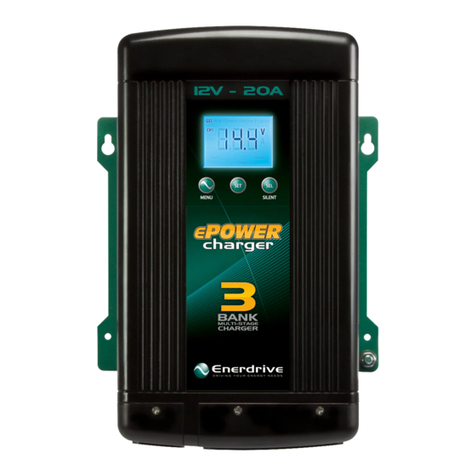
Enerdrive
Enerdrive DOMETIC EN31220 User manual

Enerdrive
Enerdrive ePOWER DC2DC User manual
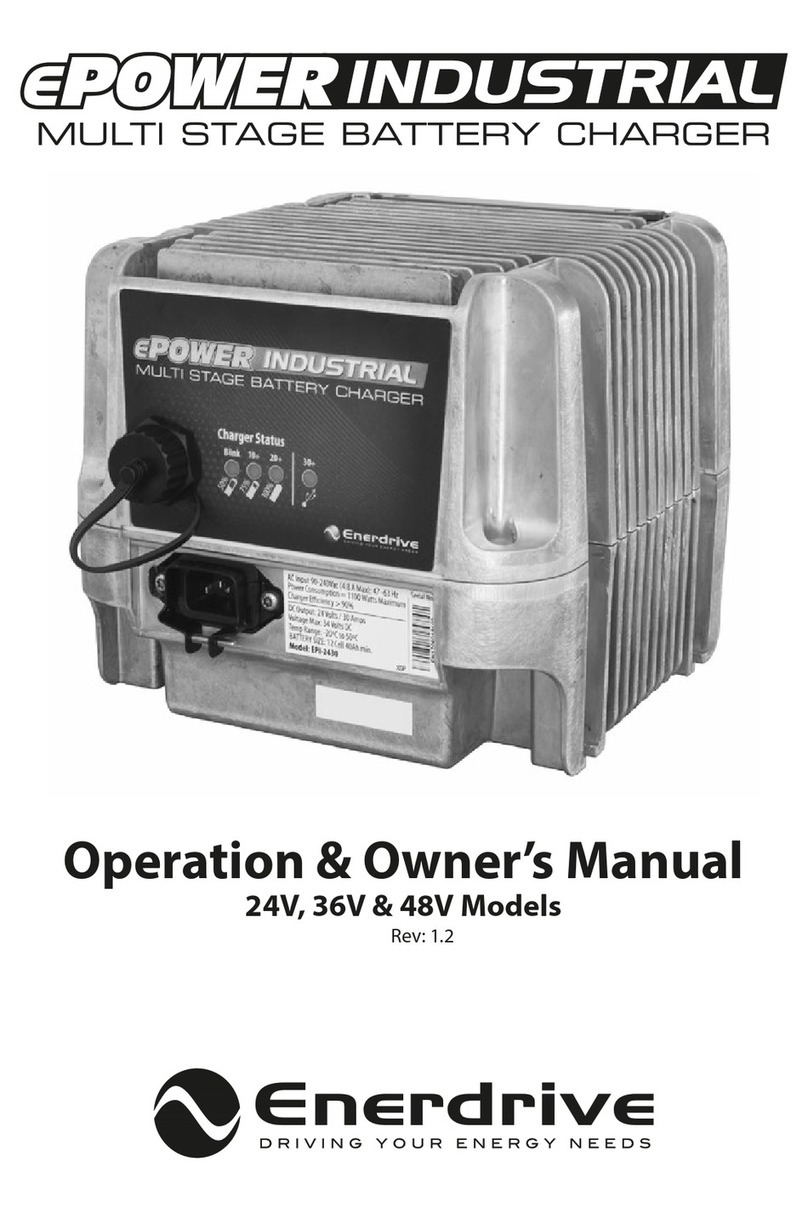
Enerdrive
Enerdrive ePower Industrial EPI-2430 User manual
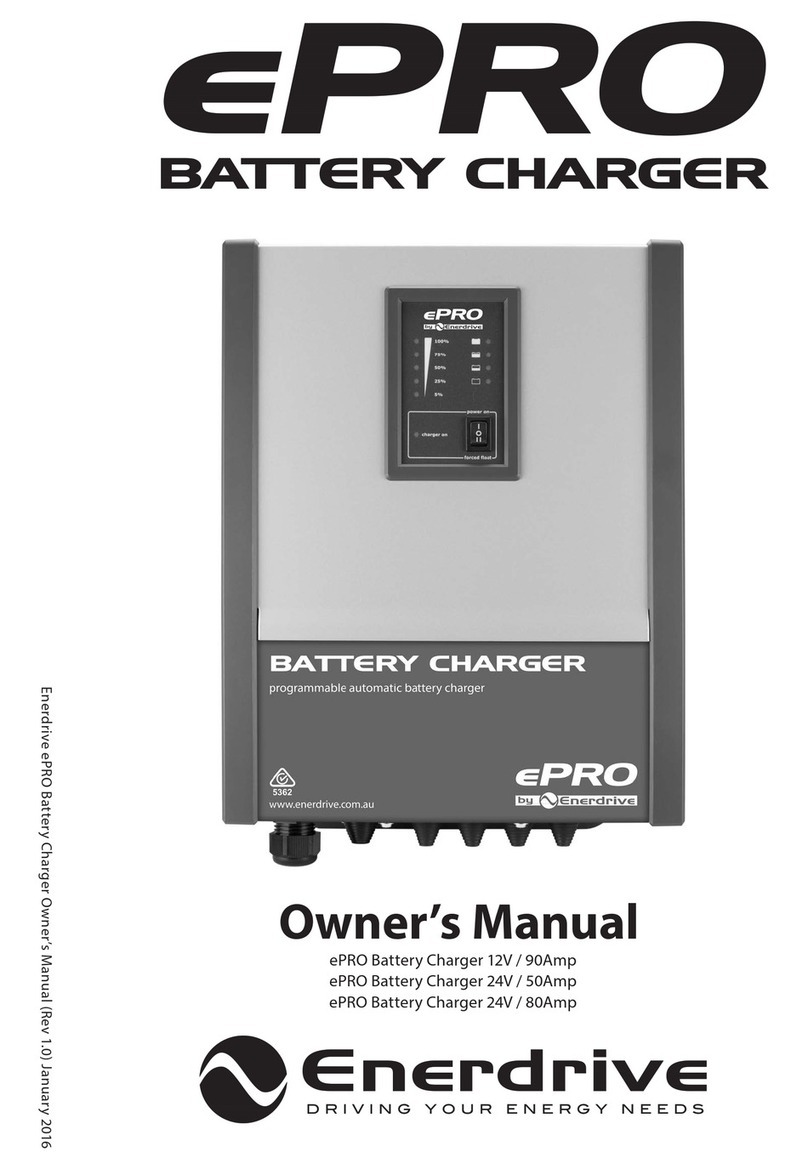
Enerdrive
Enerdrive ePRO EPBC-1290 User manual

Enerdrive
Enerdrive ePOWER DC2DC User manual

Enerdrive
Enerdrive ePOWER Series User manual
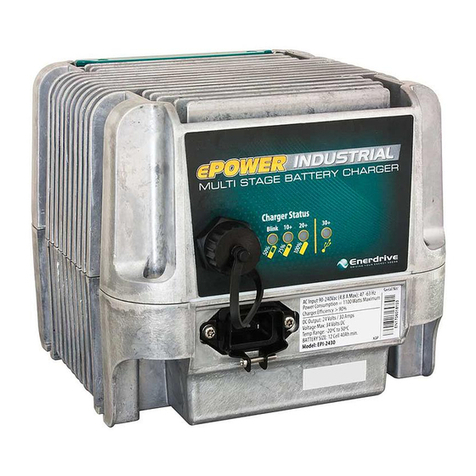
Enerdrive
Enerdrive ePower Industrial EPI-2430 User manual

